The Commercial Chicken Plucker Market is estimated to be valued at USD 352.3 million in 2025 and is projected to reach USD 667.5 million by 2035, registering a compound annual growth rate (CAGR) of 6.6% over the forecast period.
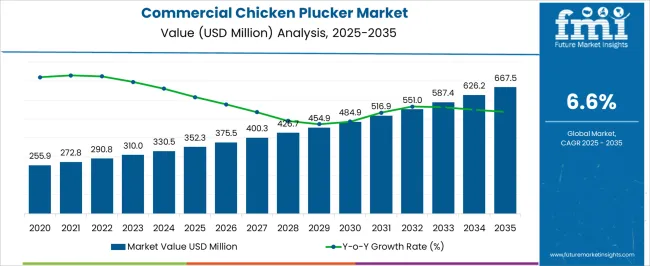
| Metric | Value |
|---|---|
| Commercial Chicken Plucker Market Estimated Value in (2025 E) | USD 352.3 million |
| Commercial Chicken Plucker Market Forecast Value in (2035 F) | USD 667.5 million |
| Forecast CAGR (2025 to 2035) | 6.6% |
The commercial chicken plucker market is gaining momentum as poultry processing operations increasingly adopt automation to improve efficiency, hygiene, and productivity. Rising global poultry consumption has accelerated the demand for equipment that reduces manual labor and ensures consistent output.
Advances in stainless steel construction, motor efficiency, and safety mechanisms have improved product reliability and lifespan, making pluckers more cost effective for commercial users. Regulatory focus on food safety and the need to reduce contamination risks are further reinforcing adoption across both small scale and large scale poultry operations.
The market outlook remains positive, supported by technological enhancements, increased poultry farming activities, and the shift toward mechanized processing solutions that ensure high throughput and reduced processing time.
The market is segmented by Type, Operating Mode, Application, and Sales Channel and region. By Type, the market is divided into Horizontal Chicken Plucker and Vertical Chicken Plucker. In terms of Operating Mode, the market is classified into Automatic, Semi-automatic, and Manual. Based on Application, the market is segmented into Poultry Farms, Food Processing Plants, Hatcheries, Slaughterhouses, and Others. By Sales Channel, the market is divided into Direct Sales and Agro Stores. Regionally, the market is classified into North America, Latin America, Western Europe, Eastern Europe, Balkan & Baltic Countries, Russia & Belarus, Central Asia, East Asia, South Asia & Pacific, and the Middle East & Africa.
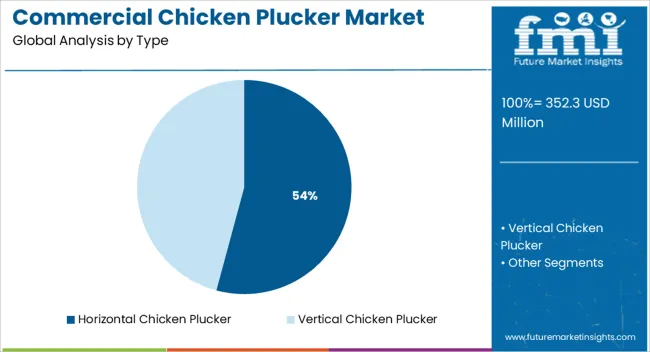
The horizontal chicken plucker type segment is projected to hold 54.20% of total market revenue by 2025, making it the leading product type. Its dominance is attributed to higher efficiency in handling large batches of poultry, reduced plucking time, and uniformity in output quality.
The design supports robust operation, ease of cleaning, and long term durability, which are highly valued in commercial processing environments. Additionally, its ability to manage high volumes without frequent downtime has strengthened its preference among poultry processors.
As production scales continue to increase globally, the horizontal chicken plucker type is expected to remain the most widely adopted configuration.
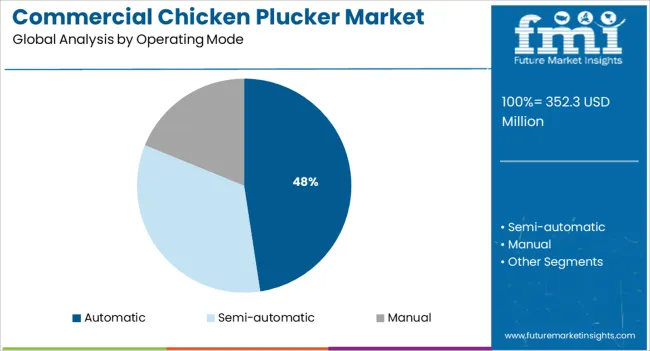
The automatic operating mode segment is expected to account for 47.60% of total market revenue by 2025 within the operating mode category, positioning it as the dominant choice. Its growth is driven by the need for labor efficiency, consistent processing quality, and reduced manual intervention.
Automatic pluckers offer time savings, improved safety, and enhanced throughput compared to manual models. The rising focus on cost optimization and workforce reduction in poultry processing has further supported the adoption of automatic systems.
As poultry farms and processors prioritize automation, this segment continues to lead due to its scalability and operational efficiency.
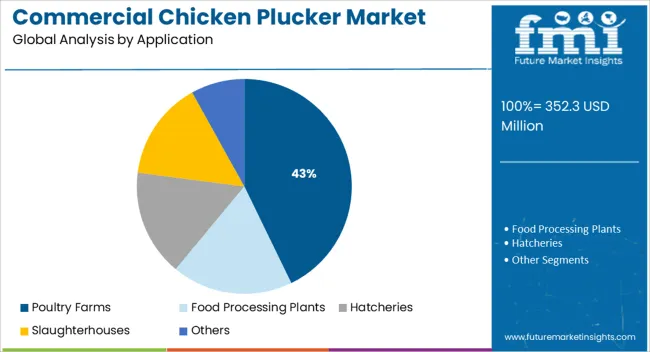
The poultry farms application segment is projected to represent 42.80% of the overall market revenue by 2025, emerging as the leading end use category. This prominence is due to the growing poultry farming industry, where efficiency, hygiene, and speed are critical to operations.
Poultry farms increasingly rely on commercial pluckers to process large bird volumes with minimal labor input, improving turnaround times and overall productivity. Enhanced food safety standards and rising consumer demand for processed poultry have further encouraged farm level adoption.
As farms expand operations to meet global poultry demand, the poultry farms application segment is set to remain a major driver of the market.
The commercial chicken plucker market is projected to register a CAGR of 6.6% between 2025 and 2035. Historically, the market presented moderate growth from 2020 to 2025, exhibiting a CAGR of 5.9%.
Regardless of the increasing vegan trend, many people have been found to still be eating meat and poultry products. This tendency is noticeable in many countries where it is believed that a significant portion of the population has moved to a plant-based diet. Given the various health benefits of food items containing chicken flesh, there is a surge in demand for commercial chicken pluckers. Several more nutrients that are present in chicken meat products also support the health of the reproductive system and the brain.
These factors are anticipated to support a 1.9X increase in the commercial chicken plucker market between 2025 and 2035. The market is projected to be worth USD 667.5 million by the end of 2035, according to FMI analysts.
| 2020 | USD 206.1 million |
|---|---|
| 2024 | USD 274.6 million |
| 2025 | USD 290.8 million |
| 2025 | USD 310 million |
| 2035 | USD 667.5 million |
The industry is expected to grow as demand for processed poultry products increases. The increased demand for convenience meals and the rising consumption of processed chicken are both expected to increase the need for commercial plucking equipment. Since red meat consumption drops due to health concerns, there is likely be an increase in demand for chicken products with high amounts of protein. For processed poultry products, high-quality commercial chicken plucker equipment is required, which is projected to drive market expansion.
Chicken pluckers are being used by fast food restaurants promptly to satisfy customer demand fast and efficiently. Popular fast food chains like KFC, McDonald's Corporation, Taco Bell and Domino's are expanding their footprint into new countries. Over the forecast period, this is anticipated to increase the deployment of commercial chicken pluckers.
The manufacturers of commercial chicken pluckers concentrate on developing advanced de-feathering equipment. The primary opportunity for market expansion is the creation of automated commercial chicken pluckers and the rising importance of food safety and cleanliness. The demand is also expected to rise since automated commercial chicken pluckers are more effective and humane than manual pluckers.
Owing to this newly created machinery, several food products made of chicken meat now have extended shelf life. Additionally, market advancements help items retain the majority of their nutrients while reducing quality loss and avoiding disease contamination. Therefore, the industry's innovative concepts are anticipated to boost demand for its devices.
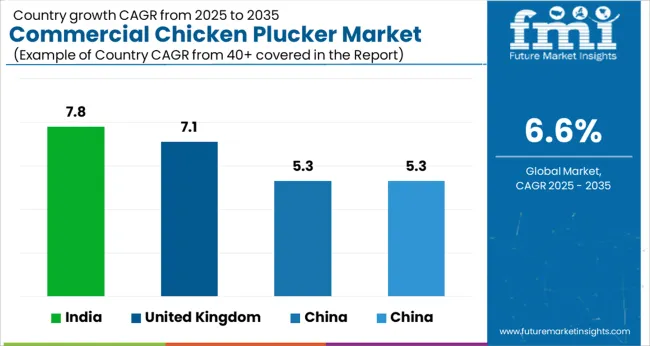
The market is expected to be dominated by a horizontal plucker segment during the projected period. There is a rising demand for horizontal commercial chicken pluckers as a result of technical developments in commercial pluckers and the inclusion of automated equipment operations. The main shaft moves the revolving plate directly as it rotates in a horizontal direction. This concept differentiates between horizontal and vertical retraction systems.
The horizontal circular plucker has the advantage that the installation number of the rotary drums is significantly reduced by using a circular processing method. With this type of commercial chicken pluckers, the cost is decreased, the space is saved, and the degree of poultry processing is controllable. Additionally, since the horizontal circular plucker uses little power, the necessary power can be provided by a standard civil power supply, greatly expanding the range of applications. Therefore, end-users prefer using commercial horizontal chicken pluckers, which is likely to lead to market expansion.
The semi-automatic chicken pluckers segment now controls a sizeable portion of the global market based on the operating mode. The automatic equipment, however, is expected to develop rapidly in terms of CAGR throughout the forecast period, according to FMI. This is due to the increased usage of commercial chicken pluckers in poultry farms, slaughterhouses, and food processing facilities.
Despite being an expensive choice, de-feathering chicken is easily accomplished by utilizing automatic chicken pluckers. With little to no user involvement, these machines can complete the full chicken-plucking process in as little as two minutes. Hence, several end users are indicating a desire to deploy these devices in their facilities to increase overall production and decrease manpower needs.
| Country | Market Value (2025) |
|---|---|
| United States | USD 91.4 million |
| Germany | USD 47.3 million |
| United Kingdom | USD 27.9 million |
| China | USD 26.7 million |
| Japan | USD 15.4 million |
| India | USD 11.6 million |
North America is anticipated to have significant growth over the projection period as a result of urbanization and the proliferation of fast food and restaurant chain. The USA is likely to dominate the market as the nation is the birthplace of the fast food industry. Market participants cope with the varied consumers' need for processed meat in the country.
In this country, there is a considerable demand for processed foods, notably processed meat. To accommodate this demand, local manufacturers are developing state-of-the-art chicken slaughtering and plucking equipment. The National Chicken Council predicts that in 2025, an average person will consume 99.6 pounds of chicken. The sales of chicken pluckers throughout the nation are likely to increase as a result. This is predicted to fuel the growth of the USA commercial chicken plucker market during the forecast period.
| Country | United States |
|---|---|
| Market Value (2025) | 31.4% |
Given its high protein content, chicken is one of the significant meal components in the nation. Thus, manufacturers are using perfect techniques to promptly deliver commercial poultry pluckers to satisfy the market's demand for meat products. By 2024, there are likely to be 4,500 plucking machines in operation nationwide, up from around 1,500 in 2000, according to the USDA. Moreover, the USA is home to key commercial chicken pluckers manufacturers like Smithfield Foods, Tyson Foods, and Perdue Farms.
The United Kingdom follows Germany in the production of meat and poultry, which requires numerous machinery and yields high profits. The growing popularity of fast food and restaurant chains, as well as increased demand for processed meat, are driving the market.
Market expansion is also predicted to be fueled by innovations in the food processing sector. This includes the unification of all process equipment into a single piece to save labor costs and increase cleanliness standards. Important domestic businesses that provide a range of commercial pluckers are also promoting market growth. Unilever plc., for instance, offers commercial chicken pluckers all over the world.
| Country | United Kingdom |
|---|---|
| CAGR (2025 to 2035) | 7.1% |
| Market Share (2025) | 9.6% |
| Market Value (2035) | USD 55.3 million |
Rising per capita income and consumer tendencies toward value-added food are key factors in enhancing market sales potential. Technological innovations like the unification of all machine components into a single piece to minimize labor needs are also anticipated to fuel market expansion. Growing food processing automation is projected to present the hugest potential for the United Kingdom commercial chicken plucker market.
In Germany, several developments have occurred in the chicken meat processing industry during the past five years. In addition, changes in customer behavior led to price changes throughout the whole value chain.
| Country | Germany |
|---|---|
| Market Share (2025) | 16.3% |
German commercial chicken plucker market has a substantial share in the European Union owing to its extensive meat production. As a result, the need for equipment grows yearly. It is projected that chicken consumption per person would rise in the following years.
As far as the CAGR is concerned, India is expected to have considerable growth in the Asia Pacific region during the forecast period. In India, the proportion of non-vegetarians is rising gradually. The growth in disposable income is the main cause of this. Additionally, people increasingly enjoy eating out more often than they do at home and can buy poultry items like chicken. Therefore, as demand rises in both the domestic and restaurant sectors, so does the need for chicken pluckers. This is causing the Indian commercial chicken plucker market’s profitable expansion.
| Country | India |
|---|---|
| CAGR (2025 to 2035) | 7.8% |
| Market Share (2025) | 4.0% |
| Market Value (2035) | USD 24.4 million |
Over the past few decades, the Indian poultry sector has made major advancements, switching from conventional agricultural practices to industrial production techniques. The sector makes use of cutting-edge technological advancements. The manufacturers of chicken pluckers are taking advantage of this. In the upcoming years, the country's poultry industry is anticipated to expand further.
Commercial chicken pluckers are being adopted speedily by chicken suppliers, who deliver to everyone from small restaurants to huge food caterers. Businesses in Japan are focusing on chicken processing methods with an emphasis on business return. The recent Global Agricultural Information Network (GAIN) report from the USDA identifies household consumption of meat products among Japanese consumers as one of the significant trends for 2025.
| Country | Japan |
|---|---|
| Market Share (2025) | 5.3% |
The Japanese commercial chicken plucker market is anticipated to develop at a rapid rate due to the rising per capita income and the inclination of consumers for high-protein food products. Japan is renowned around the world for its technical innovations. Therefore, the increased technological innovation and acceptance are projected to provide market possibilities throughout the forecast period.
The population of China is expanding quickly. A significant rise in the demand for high-protein meals like processed meat is anticipated throughout the projected period. This significant element is anticipated to raise demand for chicken pluckers. The amount of meat consumed in this nation is rapidly rising. This is likely to support the expansion of the Chinese commercial chicken plucker market.
| Country | China |
|---|---|
| CAGR (2025 to 2035) | 5.3% |
| Market Share (2025) | 9.2% |
| Market Value (2035) | USD 44.7 million |
Automation, intelligence, and digitization are the three apparent changes in the Chinese food industry today, especially in the poultry industry. The labor pool is also shrinking since there are so few young people willing to work in slaughterhouses. As a result, commercial chicken pluckers are being adopted with increasing frequency.

Key players in the commercial chicken plucker market include Smithfield Foods Inc., Tyson Foods, Pilgrim’s Pride Corporation, Perdue Farms, Sanderson Farms, BRF SA, Danone SA, Hain Celestial Group Inc., Unilever plc., and LEM Products. Various techniques are being used by these businesses in the industry to draw clients and boost revenue. Certain of these tactics consist of:
Creating novel and inventive products: To produce novel and distinctive commercial chicken pluckers that appeal to consumers, several businesses are concentrating and investing in research and development.
Danone SA is expanding on a distinctive array of products with a health-focused focus to play a significant role in the food revolution. The firm works to provide healthy products and better-for-you substitutes for indulgent times, offered by purpose-led companies, to satisfy such demands. Additionally, it provides a variety of options and answers for various situations.
In August 2020, to counter increasing competition in the health and nutrition industry, Danone SA and Nestle are together pushing up new product releases and developments. Danone claimed to be developing close to a dozen new items.
Using premium materials: To distinguish their goods and draw in health-conscious customers, businesses are turning to premium components. To win over consumers who might be wary of their food choices, several businesses are emphasizing the texture of chicken.
Unilever Inc., one of the top manufacturers of consumer goods in the world, was founded more than a century ago. The firm is renowned for its outstanding brands and its conviction that conducting business ethically leads to exceptional success.
In February 2025, Unilever disclosed that it has reached a deal with RS Group to sell its direct selling operation, known as Unilever Life, in Thailand. Beyond, Aviance and iFresh make up the portfolio of three brands within the Multi-Level Marketing (MLM) direct-selling business segment known as Unilever Life in Thailand.
Making ethical and transparent supply chains: To appeal to customers who are socially and ecologically sensitive, businesses are stressing sustainable and ethical practices and becoming more open about their sourcing and manufacturing processes.
Tyson Foods, Inc. is a global firm based in the United States and has proficiency in processing and marketing poultry, beef, and hog. Excellence in business, operations, and finance serve as the company's engine for growth and returns. It also promotes the development of a resilient, creative, and safe food system for everyone.
In February 2025, on the site of Tyson's new $352.3 million meat processing facility, Bowling Green and Tyson Foods laid the foundation stone. Once completed in late 2025, the 400,000-square-foot factory will employ 450 people and assist in supplying the company's renowned Jimmy Dean® and Wright® brands, which are in high demand.
Extending their network of distribution: To reach a larger client base and make their products more accessible to customers through various channels, such as direct sales through supermarkets, online sales, and specialty shops, businesses are increasing their distribution networks.
LEM Products is a pioneer in meat and game processing machinery. Its objective is to provide hunters, processors, and home cooks with high-quality goods. It is simple to process, prepare, and preserve your crop and foods thanks to LEM's selection of goods. It carries more than 800 distinct goods, all of which are sold both online and in more than 3,500 physical shops across the US and Canada.
In September 2020, the achievement of ISO 9001:2020 Certification was announced by LEM Products, Inc. The Certification Scope covers imaging and converting for use as signs, tags, labels, or product identification goods.
Tying partnership with other ventures: To further their penetration into profitable industries and increase productivity to increase their global footprint while also expanding their product portfolio, they are also building strong relationships with other businesses in the poultry and restaurant industries, particularly with those who require a significant amount of commercial chicken pluckers.
Smithfield Foods, Inc. manufactures and sells a range of packaged and fresh meat products both locally and abroad. Pork, Hog Production, International, and Corporate are its four business sectors, each of which has several subsidiaries, joint ventures, and other assets.
In November 2025, a deal was made by Smithfield Europe, a division of Smithfield Foods, to buy Goodies Meat Production SRL, a Romanian manufacturer of private-label packaged meat products for the retail market.
These tactics may differ between businesses and change over time. However, their common goal is to appeal to the target market and boost sales.
The global commercial chicken plucker market is estimated to be valued at USD 352.3 million in 2025.
The market size for the commercial chicken plucker market is projected to reach USD 667.5 million by 2035.
The commercial chicken plucker market is expected to grow at a 6.6% CAGR between 2025 and 2035.
The key product types in commercial chicken plucker market are horizontal chicken plucker and vertical chicken plucker.
In terms of operating mode, automatic segment to command 47.6% share in the commercial chicken plucker market in 2025.
The global commercial chicken plucker market is estimated to be valued at USD 352.3 million in 2025.
The market size for the commercial chicken plucker market is projected to reach USD 667.5 million by 2035.
The commercial chicken plucker market is expected to grow at a 6.6% CAGR between 2025 and 2035.
The key product types in commercial chicken plucker market are horizontal chicken plucker and vertical chicken plucker.
In terms of operating mode, automatic segment to command 47.6% share in the commercial chicken plucker market in 2025.






Our Research Products

The "Full Research Suite" delivers actionable market intel, deep dives on markets or technologies, so clients act faster, cut risk, and unlock growth.

The Leaderboard benchmarks and ranks top vendors, classifying them as Established Leaders, Leading Challengers, or Disruptors & Challengers.

Locates where complements amplify value and substitutes erode it, forecasting net impact by horizon

We deliver granular, decision-grade intel: market sizing, 5-year forecasts, pricing, adoption, usage, revenue, and operational KPIs—plus competitor tracking, regulation, and value chains—across 60 countries broadly.

Spot the shifts before they hit your P&L. We track inflection points, adoption curves, pricing moves, and ecosystem plays to show where demand is heading, why it is changing, and what to do next across high-growth markets and disruptive tech

Real-time reads of user behavior. We track shifting priorities, perceptions of today’s and next-gen services, and provider experience, then pace how fast tech moves from trial to adoption, blending buyer, consumer, and channel inputs with social signals (#WhySwitch, #UX).

Partner with our analyst team to build a custom report designed around your business priorities. From analysing market trends to assessing competitors or crafting bespoke datasets, we tailor insights to your needs.
Supplier Intelligence
Discovery & Profiling
Capacity & Footprint
Performance & Risk
Compliance & Governance
Commercial Readiness
Who Supplies Whom
Scorecards & Shortlists
Playbooks & Docs
Category Intelligence
Definition & Scope
Demand & Use Cases
Cost Drivers
Market Structure
Supply Chain Map
Trade & Policy
Operating Norms
Deliverables
Buyer Intelligence
Account Basics
Spend & Scope
Procurement Model
Vendor Requirements
Terms & Policies
Entry Strategy
Pain Points & Triggers
Outputs
Pricing Analysis
Benchmarks
Trends
Should-Cost
Indexation
Landed Cost
Commercial Terms
Deliverables
Brand Analysis
Positioning & Value Prop
Share & Presence
Customer Evidence
Go-to-Market
Digital & Reputation
Compliance & Trust
KPIs & Gaps
Outputs
Full Research Suite comprises of:
Market outlook & trends analysis
Interviews & case studies
Strategic recommendations
Vendor profiles & capabilities analysis
5-year forecasts
8 regions and 60+ country-level data splits
Market segment data splits
12 months of continuous data updates
DELIVERED AS:
PDF EXCEL ONLINE
Commercial Baking Rack Oven Market Size and Share Forecast Outlook 2025 to 2035
Commercial Blast Freezer Market Size and Share Forecast Outlook 2025 to 2035
Commercial Water Heater Market Size and Share Forecast Outlook 2025 to 2035
Commercial High-Speed Oven Market Size and Share Forecast Outlook 2025 to 2035
Commercial Turboprop Aircrafts Market Size and Share Forecast Outlook 2025 to 2035
Commercial Vehicle Foundation Brakes Market Size and Share Forecast Outlook 2025 to 2035
Commercial Vehicle Brake Chambers Market Size and Share Forecast Outlook 2025 to 2035
Commercial Vehicles LED Bar Lights Market Size and Share Forecast Outlook 2025 to 2035
Commercial Vehicle AMT Transmission Market Size and Share Forecast Outlook 2025 to 2035
Commercial Greenhouse Market Size and Share Forecast Outlook 2025 to 2035
Commercial Vessel Market Size and Share Forecast Outlook 2025 to 2035
Commercial Slush Machine Market Size and Share Forecast Outlook 2025 to 2035
Commercial Medium Voltage Distribution Panel Market Size and Share Forecast Outlook 2025 to 2035
Commercial Earth Observation (CEO) Market Size and Share Forecast Outlook 2025 to 2035
Commercial Ozone Generator Market Size and Share Forecast Outlook 2025 to 2035
Commercial Gas-Fired Boiler Market Size and Share Forecast Outlook 2025 to 2035
Commercial Deep Fryer Parts & Accessories Market Size and Share Forecast Outlook 2025 to 2035
Commercial Gas Restaurant Ranges Market Size and Share Forecast Outlook 2025 to 2035
Commercial Heat Pump Market Size and Share Forecast Outlook 2025 to 2035
Commercial Countertop Ranges Market Size and Share Forecast Outlook 2025 to 2035

Thank you!
You will receive an email from our Business Development Manager. Please be sure to check your SPAM/JUNK folder too.
Chat With
MaRIA